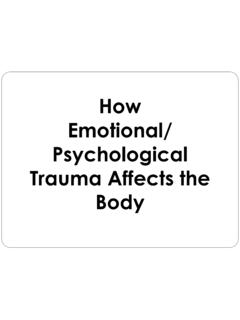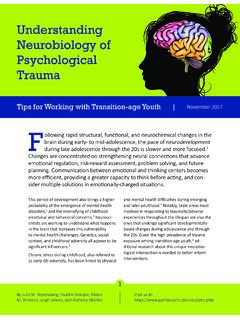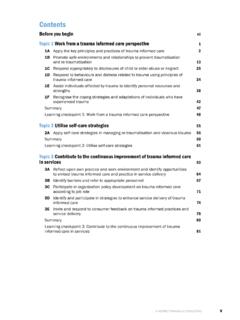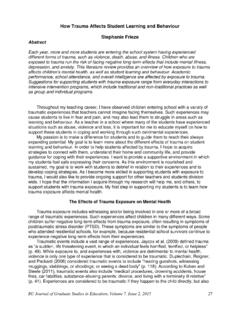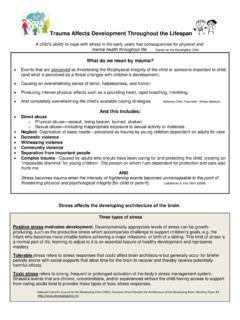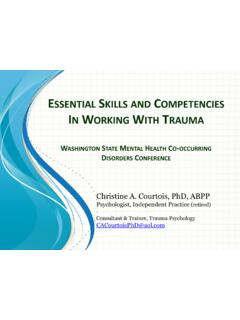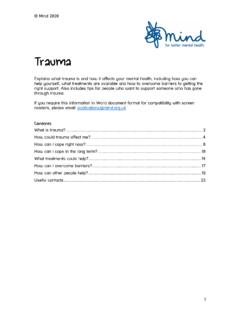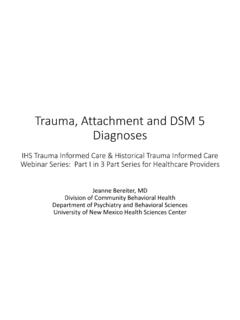Transcription of Implementing a Trauma-Informed Approach for Youth …
1 Implementing a Trauma-Informed Approach for Youth across Service Sectors This brief is based on a webinar, Implementing a Trauma-Informed Approach for Youth Across Service Sectors, held Tuesday, May 21, 2013, 2:00 to 3:30 EDT. The webinar was sponsored by the Interagency Working Group on Youth Programs (IWGYP), a collaboration of 18 Federal departments and agencies that support programs and services focusing on Youth and promote the goal of positive, healthy outcomes for Youth . The webinar was planned jointly by the IWGYP and the Substance Abuse and Mental Health Services Administration (SAMHSA). The webinar slides are housed on the IWGYP website, , under the Mental Health Youth Topic. The webinar featured three content experts nationally known in their field: Eugene Griffin, , , Northwestern University, Feinberg School of Medicine; Julian Ford, , University of Connecticut, School of Medicine; and Charles Wilson, MSSW, Chadwick Center for Children and Families Rady Children s Hospital - San Diego, California; all of whom have been supported by SAMHSA trauma -focused grants.
2 Additionally, the webinar included two Youth presenters, NC and LS, who spoke about their own lived experience and the importance of Trauma-Informed care. Both Youth are referred to only by initials to protect their privacy. NC is a peer specialist and LS is a law student. Introduction trauma affects Youth in all communities, and responses to those experiences by child-serving systems are critical. It is important for providers serving Youth to understand how best to respond and support healing. Service providers and policymakers in the Youth -serving field are continually learning more from researchi about trauma , traumatic experiences, and the various responses to traumatic events. It is important for Youth serving systems to develop a greater understanding of the association between trauma and mental health and substance use disorders, and how it can derail the healthy development of Youth .
3 The field recognizes the importance of addressing trauma and using a Trauma-Informed Approach in prevention, treatment, and recovery efforts. This brief discusses the concept and prevalence of trauma ; techniques for coping with, and recovering from trauma at an individual and systems level; the core principles for building a framework for understanding trauma ; and implementation of elements essential for a Trauma-Informed system as presented by the featured experts. Recognizing the effects of trauma and understanding how to address trauma are fundamental to the trauma and Justice Strategic Initiative at the Substance Abuse and Mental Health Services Administration (SAMHSA), a division of the Department of Health and Human Services (HHS).
4 The focus of SAMHSA s trauma and Justice Strategic Initiative is on integrating a Trauma-Informed Approach throughout health, behavioral health, and related systems to reduce the harmful effects of trauma and violence on individuals, families, and communities and using innovative strategies to reduce the involvement of individuals with trauma and behavioral health issues in the criminal and juvenile justice systems. As part of this Initiative, with the help of experts, SAMHSA will be releasing a concept paper outlining a framework for trauma and guidance for developing and Implementing a trauma -inf ormed Approach . What Do We Mean by trauma ? After an introduction by Dr. Larke Huang from the Substance Abuse and Mental Health Services Administration (SAMHSA), Dr.
5 Eugene Griffin provided a framework for understanding trauma . trauma is a complex experience that affects Youth and the systems that serve them in a variety of ways. The experience of trauma can be described through some common elements: event, experience, and effects, also known as Three E s. ii These elements address the uniqueness of an individual s response to an event and how an event affects one s future behavior and well-being. An Event is objective and measurable. T raumatic events include abuse (physical, emotional, s exual); domestic or community violence; an accident or natural disaster; and war or terrorism. 1. An Experience is subjective and difficult to measure because it relates to how someone reacts to an event.
6 It is often thought to be life threatening or physically or emotionally overwhelming, and intensity can vary among people and over time. The way one person experiences an event might differ from the way another person does; culture, gender, and age all influence one s experience of the event. Additionally, people experience events in different ways. Resilience, risk and protective factors, and supports may contribute to this experience. 2. Effects are the reactions a person has to an event and the ways an experience changes or alters that person s ongoing and future behavior. Classic symptoms include experiencing hyperarousal, such as overreacting or being hypervigilant; re-experiencing an event as n ightmares or flashbacks; and avoiding a situation by having a fight, flight, or freeze reaction.
7 The effects of a traumatic event can have a long-term impact on neurobiological development and contribute to negative physical, hormonal, and chemical changes due to stress responses. Building on this Three E s concept of trauma , SAMHSA frames its concept of trauma as: an event, series of events, or set of circumstances that is experienced by an individual as physically or emotionally harmful or life threatening and that has lasting adverse effects on the individual s functioning and mental, physical, social, emotional, or spiritual Researchersiv report that traumatic stress occurs when an extreme experience overwhelms and alters an individual s stress-related physiological systems and compromises the functioning of stress-response systems ( , neuroimmune, neuroendocrine, autonomic, and central nervous system networks).
8 What I found worked best is when I was surrounded by people who really got it, who really understood trauma . LS Prevalence of trauma Many Youth are exposed to traumatic events, including those in the juvenile justice and child welfare systems, as well as those who experience homelessness. Building on the three E s concept, we know that the experience of trauma is complex and particular to each individual s life circumstances, which can make quantifying the extent difficult. Some people experience multiple traumas; for example, a Youth who has been separated from his or her family and then experiences assault or abuse in a foster home. As many as half of all children that have been involved with the mental health, child welfare, and juvenile justice systems have experienced multiple LS and NC, two young people formerly involved with the foster care system, comment in the box above on their experiences with multiple traumas.
9 When I was seven years brothers and I were placed in foster were immediately separated, and so I felt like that was probably the first traumatic event that I experienced. LS While I was at my foster home, I had gotten into altercations with my foster brother and before he hit me, I felt NC 2 Coping with and Reactions to trauma Dr. Julian Ford provided an overview of strategies for Youth , families, and communities to recover from trauma . Recovery from the adverse effects of trauma begins with the recognition that the experience of survival threat caused by traumatic events has caused some major changes in the way a person now copes with stress. These ways of coping are necessary and effective in emergencies such as traumatic events, but they interfere with ordinary day-to-day life.
10 Youth who have experienced trauma may develop coping strategies to help them survive. Chronic Survival Coping trauma affects a Youth s relationships, sense of survival, and sense of trust and security with people. The reaction to terrible shock, stressors, challenges, and loss is chronic survival coping. An individual trying to cope or recover from serious challenges and stressors will learn techniques to survive, such as staying on edge; being vigilant, watchful, or even distrustful (hypervigilance); or using indifference to mask hopelessness. Posttraumatic Survival Coping Physically, posttraumatic survival coping reflects a change in the body , not just a mental and psychological change. It changes how a person s brain works.



